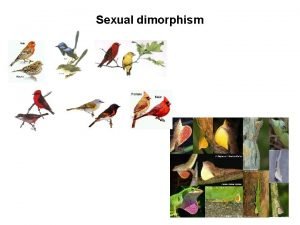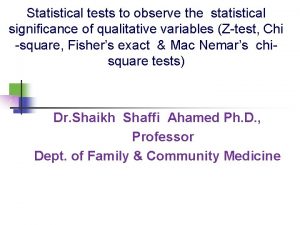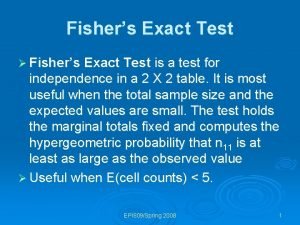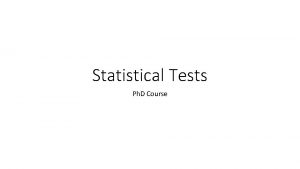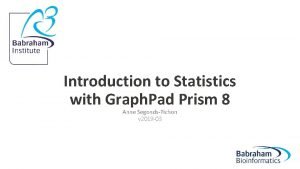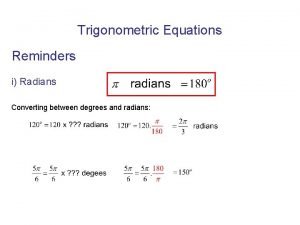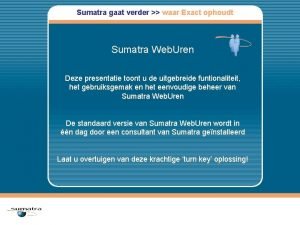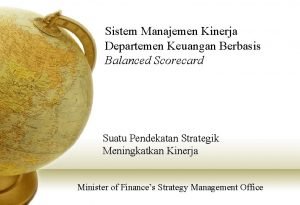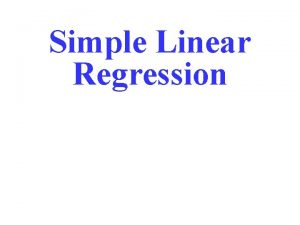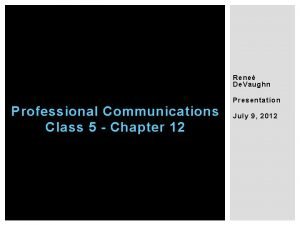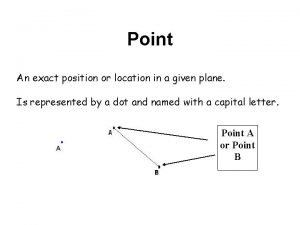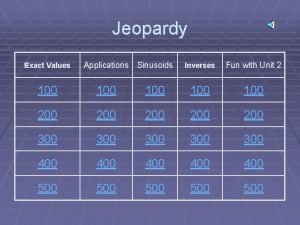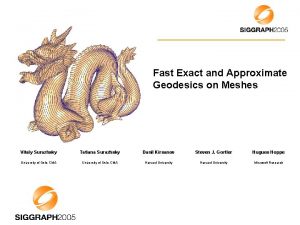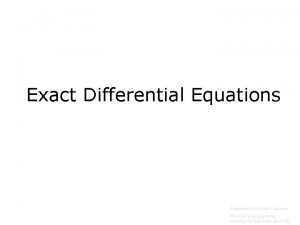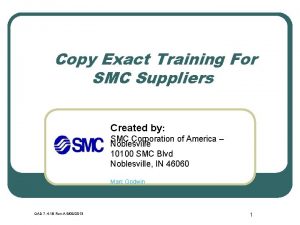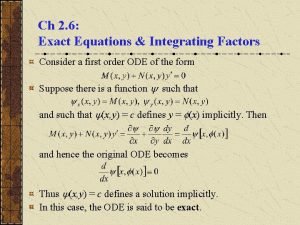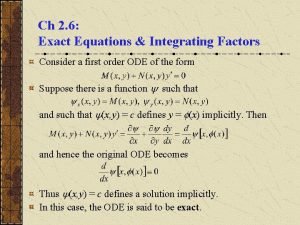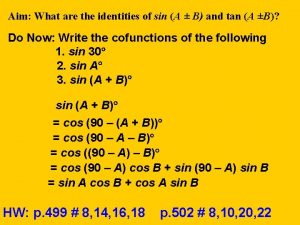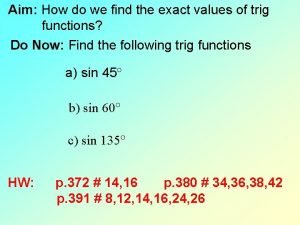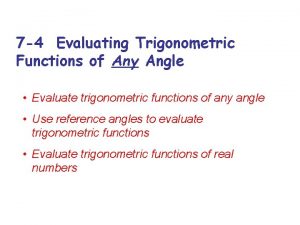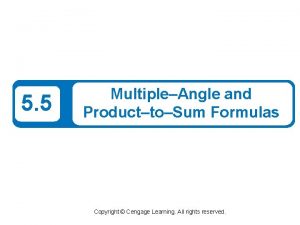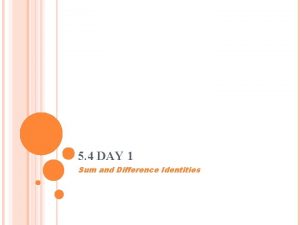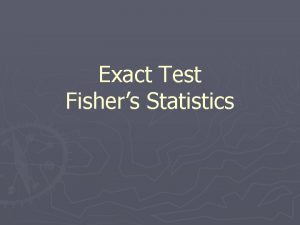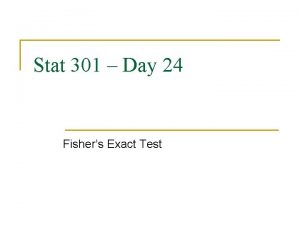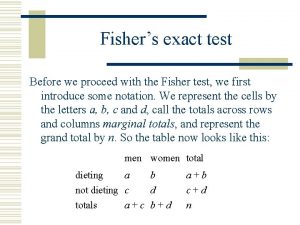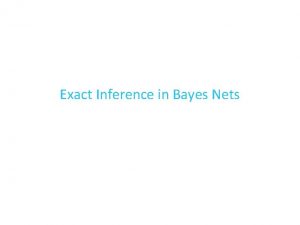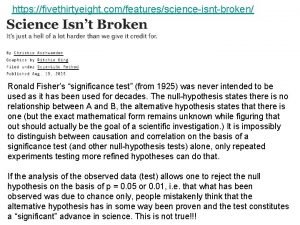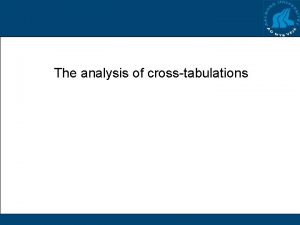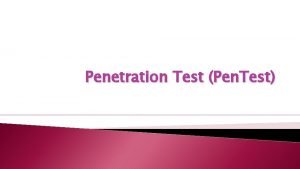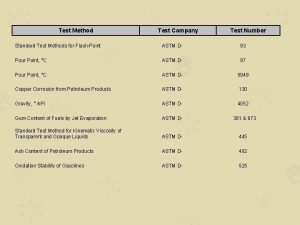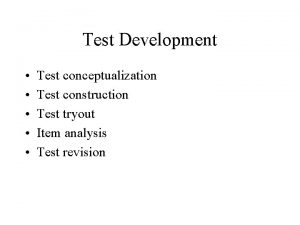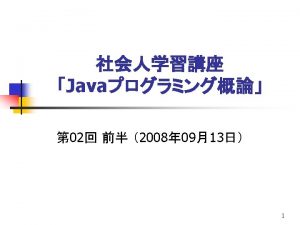Fishers Exact Test Fishers Exact Test is a




![Hypergeometric prob Pr (2, 8, 6, 9) = 10!15!8!17!/[25!2!8!6!9!] = 0. 2082 Pr (1, Hypergeometric prob Pr (2, 8, 6, 9) = 10!15!8!17!/[25!2!8!6!9!] = 0. 2082 Pr (1,](https://slidetodoc.com/presentation_image_h/f6fb21cf5a9f5fc6576151410411bc40/image-5.jpg)






























- Slides: 35

Fisher’s Exact Test Ø Fisher’s Exact Test is a test for independence in a 2 X 2 table. It is most useful when the total sample size and the expected values are small. The test holds the marginal totals fixed and computes the hypergeometric probability that n 11 is at least as large as the observed value Ø Useful when E(cell counts) < 5. EPI 809/Spring 2008 1

Hypergeometric distribution Example: 2 x 2 table with cell counts a, b, c, d. Assuming marginal totals are fixed: M 1 = a+b, M 2 = c+d, N 1 = a+c, N 2 = b+d. for convenience assume N 1<N 2, M 1<M 2. possible value of a are: 0, 1, …min(M 1, N 1). Ø Probability distribution of cell count a follows a hypergeometric distribution: N = a + b + c + d = N 1 + N 2 = M 1 + M 2 Ø l l l Ø Pr (x=a) = N 1!N 2!M 1!M 2! / [N!a!b!c!d!] Mean (x) = M 1 N 1/ N Var (x) = M 1 M 2 N 1 N 2 / [N 2(N-1)] Fisher exact test is based on this hypergeometric distr. EPI 809/Spring 2008 2

Fisher’s Exact Test Example HIV Infection yes no Hx of STDs Ø total yes 3 7 10 no 5 10 15 total 8 17 Is HIV Infection related to Hx of STDs in Sub Saharan African Countries? Test at 5% level. EPI 809/Spring 2008 3

Hypergeometric prob. Ø Probability of observing this specific table given fixed marginal totals is Pr (3, 7, 5, 10) = 10!15!8!17!/[25!3!7!5!10!] = 0. 3332 Ø Note the above is not the p-value. Why? Ø Not the accumulative probability, or not the tail probability. Ø Tail prob = sum of all values (a = 3, 2, 1, 0). EPI 809/Spring 2008 4
![Hypergeometric prob Pr 2 8 6 9 1015817252869 0 2082 Pr 1 Hypergeometric prob Pr (2, 8, 6, 9) = 10!15!8!17!/[25!2!8!6!9!] = 0. 2082 Pr (1,](https://slidetodoc.com/presentation_image_h/f6fb21cf5a9f5fc6576151410411bc40/image-5.jpg)
Hypergeometric prob Pr (2, 8, 6, 9) = 10!15!8!17!/[25!2!8!6!9!] = 0. 2082 Pr (1, 9, 7, 8) = 10!15!8!17!/[25!1!9!7!8!] = 0. 0595 Pr (0, 10, 8, 7) = 10!15!8!17!/[25!0!10!8!7!] = 0. 0059 Tail prob =. 3332+. 2082+. 0595+. 0059 =. 6068 EPI 809/Spring 2008 5

Fisher’s Exact Test SAS Codes Data dis; input STDs $ HIV $ count; cards; no no 10 No Yes 5 yes no 7 yes 3 ; run; proc freq data=dis order=data; weight Count; tables STDs*HIV/chisq fisher; run; EPI 809/Spring 2008 6

Pearson Chi-squares test Yates correction Ø Pearson Chi-squares test χ2 = ∑i (Oi-Ei)2/Ei follows a chi-squares distribution with df = (r-1)(c-1) if Ei ≥ 5. Ø Yates correction for more accurate p-value χ2 = ∑i (|Oi-Ei| - 0. 5)2/Ei when Oi and Ei are close to each other. EPI 809/Spring 2008 7

Fisher’s Exact Test SAS Output Statistics for Table of STDs by HIV Statistic DF Value Prob ƒƒƒƒƒƒƒƒƒƒƒƒƒƒƒƒƒƒƒƒƒƒƒƒƒƒƒ Chi-Square 1 0. 0306 0. 8611 Likelihood Ratio Chi-Square 1 0. 0308 0. 8608 Continuity Adj. Chi-Square 1 0. 0000 1. 0000 Mantel-Haenszel Chi-Square 1 0. 0294 0. 8638 Phi Coefficient -0. 0350 Contingency Coefficient 0. 0350 Cramer's V -0. 0350 WARNING: 50% of the cells have expected counts less than 5. Chi-Square may not be a valid test. Fisher's Exact Test ƒƒƒƒƒƒƒƒƒƒƒƒƒƒƒƒƒ Cell (1, 1) Frequency (F) 10 Left-sided Pr <= F 0. 6069 Right-sided Pr >= F 0. 7263 Table Probability (P) Two-sided Pr <= P EPI 809/Spring 2008 0. 3332 1. 0000 8

Fisher’s Exact Test The output consists of three p-values: Ø Left: Use this when the alternative to independence is that there is negative association between the variables. That is, the observations tend to lie in lower left and upper right. Ø Right: Use this when the alternative to independence is that there is positive association between the variables. That is, the observations tend to lie in upper left and lower right. Ø 2 -Tail: Use this when there is no prior alternative. Ø EPI 809/Spring 2008 9

Useful Measures of Association - Nominal Data Ø Cohen’s Kappa ( l ) Also referred to as Cohen’s General Index of Agreement. It was originally developed to assess the degree of agreement between two judges or raters assessing n items on the basis of a nominal classification for 2 categories. Subsequent work by Fleiss and Light presented extensions of this statistic to more than 2 categories. EPI 809/Spring 2008 10

Useful Measures of Association - Nominal Data Ø Cohen’s Kappa ( ) Inspector A Good Bad Good . 40 (p. B) Bad . 60 (q. B) Inspector ‘B’ . 46 (p. A) . 54 (q. A) EPI 809/Spring 2008 1. 00 11

Useful Measures of Association - Nominal Data Ø Cohen’s Kappa ( l ) Cohen’s requires that we calculate two values: • po : the proportion of cases in which agreement occurs. In our example, this value equals 0. 80. • Pe : the proportion of cases in which agreement would have been expected due purely to chance, based upon the marginal frequencies; where pe = p. Ap. B + q. Aq. B = 0. 508 for our data EPI 809/Spring 2008 12

Useful Measures of Association - Nominal Data Ø Cohen’s Kappa ( ) l Then, Cohen’s measures the agreement between two variables and is defined by = po - pe 1 - pe = 0. 593 EPI 809/Spring 2008 13

Useful Measures of Association - Nominal Data Ø Cohen’s Kappa ( ) l To test the Null Hypothesis that the true kappa = 0, we use the Standard Error: = l k 1 (1 - pe) n pe + pe 2 - pi. p. i (pi. + p. i) then z = / ~N(0, 1) EPI 809/Spring 2008 i=1 where pi. & p. i refer to row and column proportions (in textbook, ai= pi. & bi=p. i) 14

Useful Measures of Association - Nominal Data- SAS CODES Data kap; input B $ A $ prob; n=100; count=prob*n; cards; Good. 33 Good Bad. 07 Bad Good. 13 Bad. 47 ; run; proc freq data=kap order=data; weight Count; tables B*A/chisq; test kappa; run; EPI 809/Spring 2008 15

Useful Measures of Association - Nominal Data- SAS OUTPUT The FREQ Procedure Statistics for Table of B by A Simple Kappa Coefficient ƒƒƒƒƒƒƒƒƒƒƒƒƒƒƒƒ Kappa 0. 5935 ASE 0. 0806 95% Lower Conf Limit 0. 4356 95% Upper Conf Limit 0. 7514 Test of H 0: Kappa = 0 ASE under H 0 Z One-sided Pr > Z Two-sided Pr > |Z| 0. 0993 5. 9796 <. 0001 Sample Size = 100 EPI 809/Spring 2008 16

Mc. Nemar’s Test for Correlated (Dependent) Proportions EPI 809/Spring 2008 17

Mc. Nemar’s Test for Correlated (Dependent) Proportions Basis / Rationale for the Test Ø The approximate test previously presented for assessing a difference in proportions is based upon the assumption that the two samples are independent. Ø Suppose, however, that we are faced with a situation where this is not true. Suppose we randomly-select 100 people, and find that 20% of them have flu. Then, imagine that we apply some type of treatment to all sampled peoples; and on a post-test, we find that 20% have flu. EPI 809/Spring 2008 18

Mc. Nemar’s Test for Correlated (Dependent) Proportions Ø We might be tempted to suppose that no hypothesis test is required under these conditions, in that the ‘Before’ and ‘After’ p values are identical, and would surely result in a test statistic value of 0. 00. Ø The problem with this thinking, however, is that the two sample p values are dependent, in that each person was assessed twice. It is possible that the 20 people that had flu originally still had flu. It is also possible that the 20 people that had flu on the second test were a completely different set of 20 people! EPI 809/Spring 2008 19

Mc. Nemar’s Test for Correlated (Dependent) Proportions Ø It is for precisely this type of situation that Mc. Nemar’s Test for Correlated (Dependent) Proportions is applicable. Ø Mc. Nemar’s Test employs two unique features for testing the two proportions: * a special fourfold contingency table; with a * special-purpose chi-square ( 2) test statistic (the approximate test). EPI 809/Spring 2008 20

Mc. Nemar’s Test for Correlated (Dependent) Proportions Nomenclature for the Fourfold (2 x 2) Contingency Table where A B (A + B) C D (C + D) (A+B) + (C+D) = (A+C) + (B+D) = number of units evaluated and where (A + C) (B + D) n EPI 809/Spring 2008 df = 1 21

Mc. Nemar’s Test for Correlated (Dependent) Proportions Underlying Assumptions of the Test 1. Construct a 2 x 2 table where the paired observations are the sampling units. 2. Each observation must represent a single joint event possibility; that is, classifiable in only one cell of the contingency table. 3. In it’s Exact form, this test may be conducted as a One Sample Binomial for the B & C cells EPI 809/Spring 2008 22

Mc. Nemar’s Test for Correlated (Dependent) Proportions Underlying Assumptions of the Test Ø 4. The expected frequency (fe) for the B and C cells on the contingency table must be equal to or greater than 5; where fe = (B + C) / 2 from the Fourfold table EPI 809/Spring 2008 23

Mc. Nemar’s Test for Correlated (Dependent) Proportions Sample Problem A randomly selected group of 120 students taking a standardized test for entrance into college exhibits a failure rate of 50%. A company which specializes in coaching students on this type of test has indicated that it can significantly reduce failure rates through a four-hour seminar. The students are exposed to this coaching session, and re-take the test a few weeks later. The school board is wondering if the results justify paying this firm to coach all of the students in the high school. Should they? Test at the 5% level. EPI 809/Spring 2008 24

Mc. Nemar’s Test for Correlated (Dependent) Proportions Sample Problem The summary data for this study appear as follows: EPI 809/Spring 2008 25

Mc. Nemar’s Test for Correlated (Dependent) Proportions The data are then entered into the Fourfold Contingency table: Before Pass Fail 56 56 112 4 4 8 60 60 120 After Fail EPI 809/Spring 2008 26

Mc. Nemar’s Test for Correlated (Dependent) Proportions Ø Step I : State the Null & Research Hypotheses H 0 : 1 = 2 H 1 : 1 2 where 1 and 2 relate to the proportion of observations reflecting changes in status (the B & C cells in the table) Ø Step II : = 0. 05 EPI 809/Spring 2008 27

Mc. Nemar’s Test for Correlated (Dependent) Proportions Ø Step III : State the Associated Test Statistic = { ABS (B - C) - 1 } 2 2 B+C EPI 809/Spring 2008 28

Mc. Nemar’s Test for Correlated (Dependent) Proportions Ø Step IV : State the distribution of the Test Statistic When Ho is True 2 d = 2 with 1 df when Ho is True EPI 809/Spring 2008 29

Mc. Nemar’s Test for Correlated (Dependent) Proportions Step V : Reject Ho if ABS ( 2 ) > 3. 84 X² Distribution Chi-Square Curve w. df=1 0 3. 84 EPI 809/Spring 2008 X² 30

Mc. Nemar’s Test for Correlated (Dependent) Proportions Ø Step VI : Calculate the Value of the Test Statistic Ø 2 { ABS (56 - 4) - 1 } = 2 = 43. 35 56 + 4 EPI 809/Spring 2008 31

Mc. Nemar’s Test for Correlated (Dependent) Proportions-SAS Codes Data test; input Before $ After $ count; cards; pass 56 pass fail 56 fail pass 4 fail 4; run; proc freq data=test order=data; weight Count; tables Before*After/agree; run; EPI 809/Spring 2008 32

Mc. Nemar’s Test for Correlated (Dependent) Proportions-SAS Output Statistics for Table of Before by After Mc. Nemar's Test ƒƒƒƒƒƒƒƒƒƒƒƒ Statistic (S) 45. 0667 DF 1 Pr > S <. 0001 Without the correction Sample Size = 120 EPI 809/Spring 2008 33

Conclusion: What we have learned 1. Comparison of binomial proportion using Z and 2 Test. 2. Explain 2 Test for Independence of 2 variables 3. Explain The Fisher’s test for independence 4. Mc. Nemar’s tests for correlated data 5. Kappa Statistic 6. Use of SAS Proc FREQ EPI 809/Spring 2008 34

Conclusion: Further readings Read textbook for 1. Power and sample size calculation 2. Tests for trends EPI 809/Spring 2008 35
 Southpoint village apartments fishers indiana
Southpoint village apartments fishers indiana Fishers island high school
Fishers island high school Fishers health department
Fishers health department Fisher runaway hypothesis
Fisher runaway hypothesis Social hierarchy of aztecs
Social hierarchy of aztecs Fishers health department
Fishers health department Fisher exact test
Fisher exact test Fisher exact test
Fisher exact test Test exact sign
Test exact sign Proc freq
Proc freq Fisher's exact test
Fisher's exact test Fisher's exact test prism
Fisher's exact test prism Higher maths exact values
Higher maths exact values Exact cell decomposition
Exact cell decomposition Exact differential equation
Exact differential equation Sin and cos
Sin and cos Sumatra exact
Sumatra exact Kpi exact dan proxy
Kpi exact dan proxy Exact linear relationship
Exact linear relationship Exact path
Exact path Exact values chart
Exact values chart A shape formed by two rays diverging from a common vertex
A shape formed by two rays diverging from a common vertex Rhyming pattern
Rhyming pattern Find the exact value sec(135 degrees )
Find the exact value sec(135 degrees ) Cos135 exact value
Cos135 exact value Fast exact and approximate geodesics on meshes
Fast exact and approximate geodesics on meshes Exact differential equation
Exact differential equation Copy exact training
Copy exact training Integrating factor non exact equations
Integrating factor non exact equations Exact equation
Exact equation Sin 30 exact value
Sin 30 exact value Exact value of sin 105°
Exact value of sin 105° Sin 240
Sin 240 Evaluating trigonometric functions
Evaluating trigonometric functions Exact value of sin 105°
Exact value of sin 105° Cos 195 sum and difference
Cos 195 sum and difference



